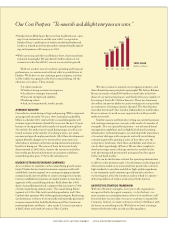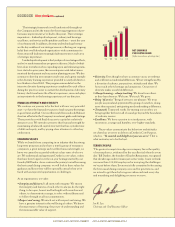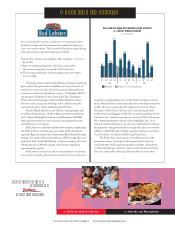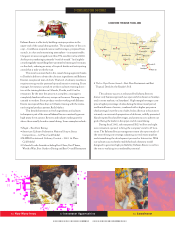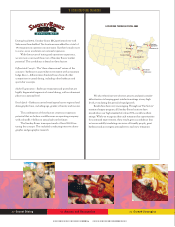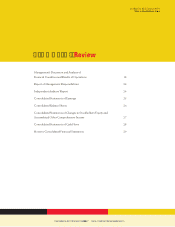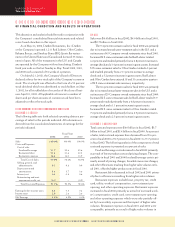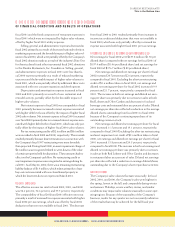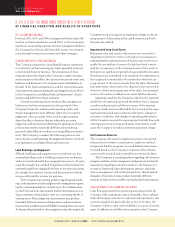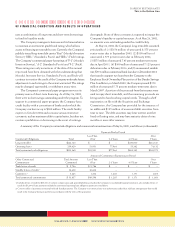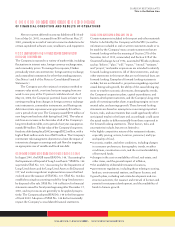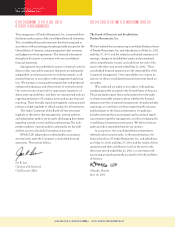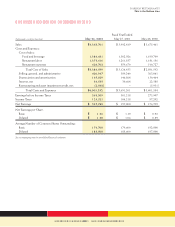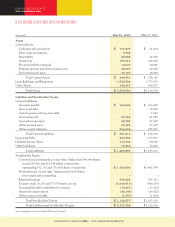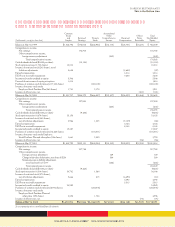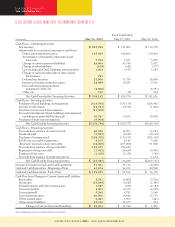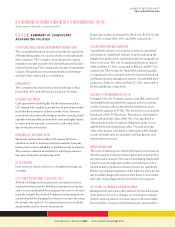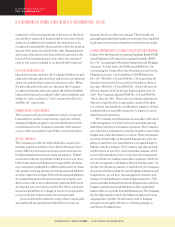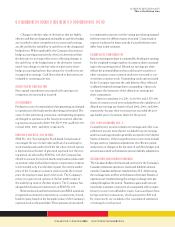Red Lobster 2002 Annual Report Download - page 24
Download and view the complete annual report
Please find page 24 of the 2002 Red Lobster annual report below. You can navigate through the pages in the report by either clicking on the pages listed below, or by using the keyword search tool below to find specific information within the annual report.
ManagementÕs Discussion and Analysis
OF FINANCIAL CONDITION AND RESULTS OF OPERATIONS
DARDEN RESTAURANTS
This is the Bottom Line
uses a combination of long-term and short-term borrowings
to fund its liquidity needs.
The Company manages its business and its financial ratios
to maintain an investment grade bond rating, which allows
access to financing at reasonable costs. Currently, the Company’s
publicly issued long-term debt carries “Baa1” (Moody’s Investors
Service), “BBB+” (Standard & Poor’s) and “BBB+” (Fitch) ratings.
The Company’s commercial paper has ratings of “P-2” (Moody’s
Investors Service), “A-2” (Standard & Poor’s) and “F-2” (Fitch).
These ratings are only accurate as of the date of this annual
report and have been obtained with the understanding that
Moody’s Investors Service, Standard & Poor’s, and Fitch will
continue to monitor the credit of the Company and make future
adjustments to such ratings to the extent warranted. The ratings
may be changed, superseded, or withdrawn at any time.
The Company’s commercial paper program serves as its
primary source of short-term financing. As of May 26, 2002,
there were no borrowings outstanding under the program. To
support its commercial paper program, the Company has a
credit facility with a consortium of banks under which the
Company can borrow up to $300 million. The credit facility
expires in October 2004 and contains various restrictive
covenants, such as maximum debt to capital ratios, but does not
contain a prohibition on borrowing in the event of a ratings
downgrade. None of these covenants is expected to impact the
Company’s liquidity or capital resources. As of May 26, 2002,
no amounts were outstanding under the credit facility.
At May 26, 2002, the Company’s long-term debt consisted
principally of: (1) $150 million of unsecured 8.375 percent
senior notes due in September 2005, (2) $150 million of
unsecured 6.375 percent notes due in February 2006,
(3) $75 million of unsecured 7.45 percent medium-term notes
due in April 2011, (4) $100 million of unsecured 7.125 percent
debentures due in February 2016, and (5) an unsecured, variable
rate, $39.1 million commercial bank loan due in December 2018
that is used to support two loans from the Company to the
Employee Stock Ownership Plan portion of the Darden Savings
Plan. In addition, in March 2002, the Company issued $150
million of unsecured 5.75 percent medium-term notes due in
March 2007. A portion of the proceeds from the issuance were
used to repay short-term debt, and the remaining proceeds are
being used to fund working capital needs. Through a shelf
registration on file with the Securities and Exchange
Commission, the Company has provided for the issuance of
an additional $125 million of unsecured debt securities from
time to time. The debt securities may bear interest at either
fixed or floating rates, and may have maturity dates of nine
months or more after issuance.
Great Food and Beverage 21 Produce Great Results in 2002
A summary of the Company’s contractual obligations and commercial commitments as of May 26, 2002, is as follows (in thousands):
Payments Due by Period
Less Than After
Contractual Obligations Total 1 Year 2-3 Years 4-5 Years 5 Years
Long-term debt $664,140 $ – $ – $450,000 $214,140
Operating leases 259,429 51,951 77,964 55,382 74,132
Total contractual cash obligations $923,569 $51,951 $77,964 $505,382 $288,272
Amount of Commitment Expiration per Period
Other Commercial Total Amounts Less Than Over
Commitments Committed 1 Year 2-3 Years 4-5 Years 5 Years
Trade letters of credit $ 9,786 $ 9,786 $ – $ – $ –
Standby letters of credit (1) 38,608 38,608–––
Guarantees (2) 5,463 1,204 1,285 1,171 1,803
Total commercial commitments $ 53,857 $49,598 $ 1,285 $ 1,171 $ 1,803
1) Includes letters of credit for $30,000 of workers’ compensation and general liabilities accrued in the Company’s consolidated financial statements; also includes letters of
credit for $7,289 of lease payments included in contractual operating lease obligation payments noted above.
2) Consists solely of guarantees associated with sub-leased properties. The Company is not aware of any non-performance under these sub-lease arrangements that would
result in the Company having to perform in accordance with the terms of the guarantees.


